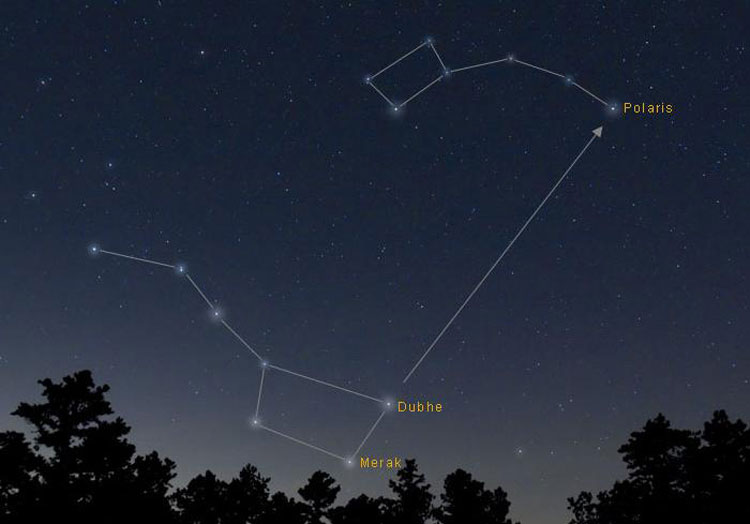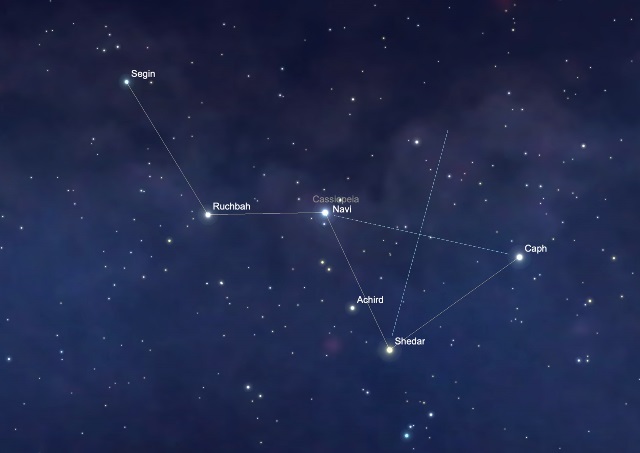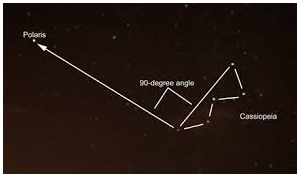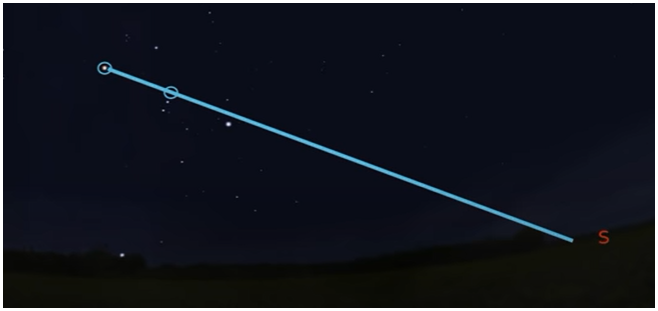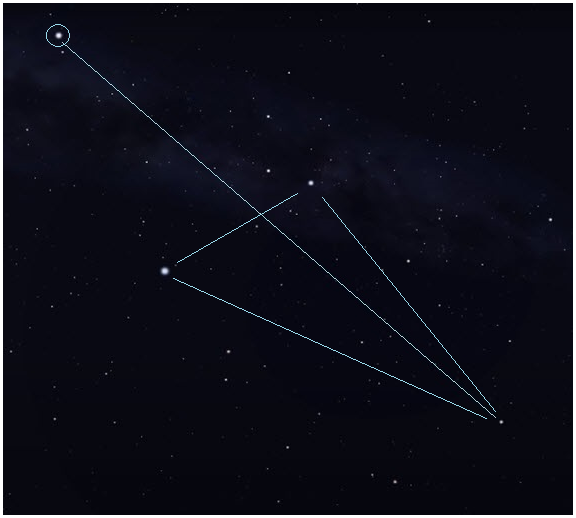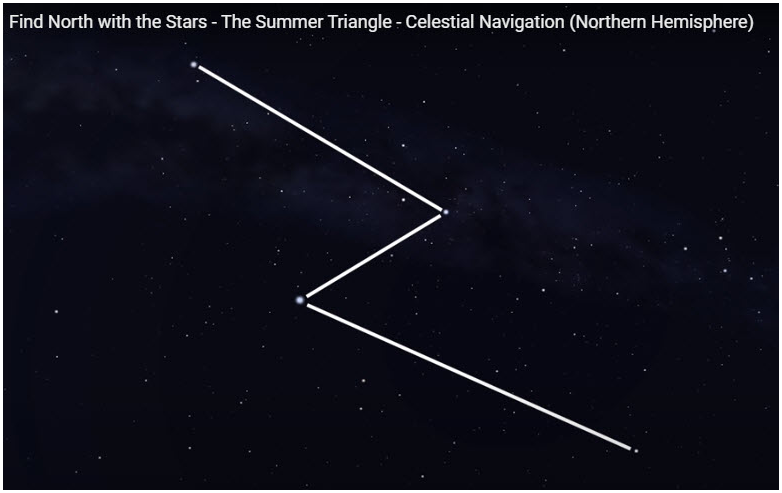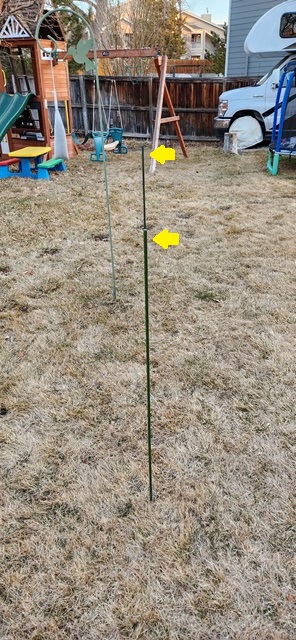A number of the other activities will need true north so we’ll deal with finding directions first. As astronomers we have identified the North Star (Polaris), so make a sketch of finding north using the familiar constellations. This can be done using any of these techniques:
1. Using the “Pointer Stars” at the end of the bowl of the Big Dipper (Ursa Major).
This is something I've known for quite some time. Probably since I was a Boy Scout in the 1960s. My first merit badge was the Astronomy one and the second was Space Exploration.
2. Using the “cleaner” triangle of Cassiopeia.
Alternatives I found while researching this topic
On the morning of 3/15/2023 about 6 am, I followed the line from the cleaner triangle (formed by the stars Shedar, Navi and Caph) thru the center line between Caph and Navi. The line projected towards Polaris was just a bit above Polaris. I found an alternate method while researching this and it was easier to make a right angls with the stars of Cass and then project the line towards Polaris. This line went very close to Polaris as best as I could draw it in the morning sky.
3. Go from the center of Orion’s Belt through his head (Meissa).
Alternatives I found while researching this topic
I was able to perform this exercise on the evening of 3/13/23. It cleared up nicely about 8:10 pm. Orion was just west of the meridian but was still vertical in orientation.
I had to close one eye and run my finger from the middle belt star, Alnilam, up thru Meissa and tried to run a straight-line overhead to the north. I have a balance issue when my head is tilted back and no matter how many times I tried it, I stumbled and my straight-line to the north was interrupted.
I laid on my back on the patio in my backyard and was able to run the line up to the north.And as this image shows, went near Polaris. It sis point to the north.
I found these two additional ways of using Orion to find north. Later the night of 3/13/23, Orion was orientated like the lower picture. Again, I laid on my back on the patio and traced a line from Bellatrix thru Alnitak to the horizon. I them made a great circle from that location, which was basically south, up thru the zenith and into the north. This method also finds north.
When Orion was tilted like this, I also ran a line thru the middle belt star thru Meissa and it did point to the north. But more NE than North. So with Orion in a tilted orientation, the running a line to the southern horizon and then making a meridian great circle will find north better.
4. Using the Summer Triangle by starting at Altair and moving through the open end of the triangle (closer to Deneb).
Alternatives I found while researching this topic
On the morning of 3/13/23 about 5 am, I ran the line from Altair, to just west of Deneb and it did find Polaris nicely.
Again, I found a couple of alternatives that also worked. Flipping the Summer Triangle over was not all that easy. It is long. I used both hands, with my thumbs together and my pinkies extended to get an approximate distance from the base of the triangle to Altair. Then I went that same distance on the other side of the base and the new apex of my pinky was close to what this picture shows. This is also a nice way to find north. Not as easy as the first way.
I found the Thunderbolt way to find Polaris fun to do. It does make a lightening bold. The picture shows the line from Altair to Vega and the line from Deneb to Polaris relatively parallel. I found them not to be parallel when I was playing with it. But the next brightest star from Deneb toward the north is Polaris. So this is an effective way to find Polaris. I found this a bit more reliable than the first method, because this is a definite asterism to use. The first uses the concept of "being close" to Deneb. How close? Knowing where Polaris is, I know how close.
5. The shadow (dip) method works well in the daytime and was the method used in the previously mention movie. Find true north and put down markers that you can refer to for future activities. The markers will help you locate the meridian for other activities below. Place a compass so that it can be seen with the markers and take a picture. Finally measure the magnetic declination (difference between magnetic and true north) using your apparatus and your location. If you can, repeat the activity at a second location a few hours from where you live so you can see that location offsets really do matter.
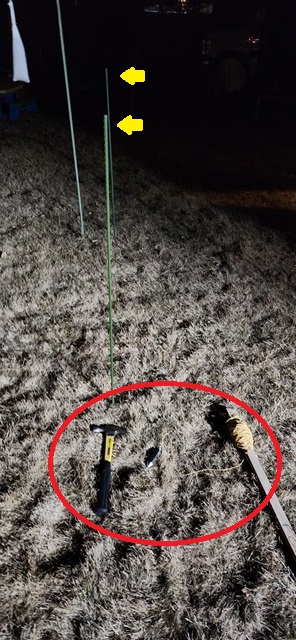
I used a plumb bob on a long string to find the celestial north. I did this same exercise while doing the Analemma observing program.
I drove the front stake into the ground and then using a string and plumb-bob, I sighted Polaris and aligned the vertical string with the first post. When all were in alignment, I drove the second, back stake into the ground. The tools I used are seen inside the red circle. The yellow twine is about 30 years old. I found the stake and the twine all over my yard at this house when we moved it. I've used this twine to mark all kinds of projects, including this one.
Measuring the magnetic declination
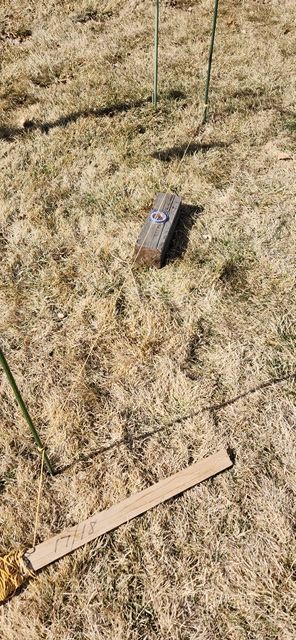
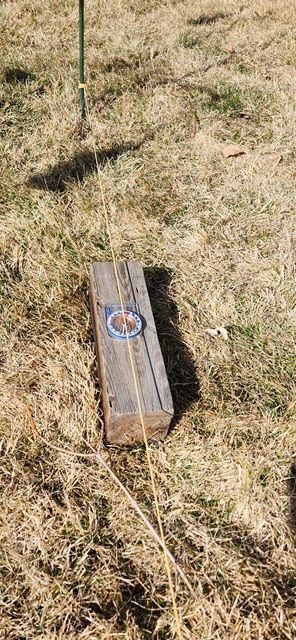
I stretched the twine between the two stakes aligned with the celestiaon north. Then I positioned my compass under the line and turned the dial to find the magnetic deviation.
Holding the twine aside with my leg, you can see from my location, 1425 Snowberry Lane, Broomfield, CO, the magnetic deviation from celestial north and magnetic north is about 14 degrees.
I noticed if I got my phone too close to the compass to take a picture, it effected it's ability to point to magnetic north. I found that to be fascinating. I did not know my cell phone emitted such an electro-magnetic field.
